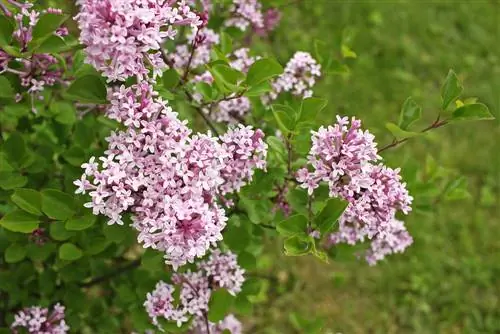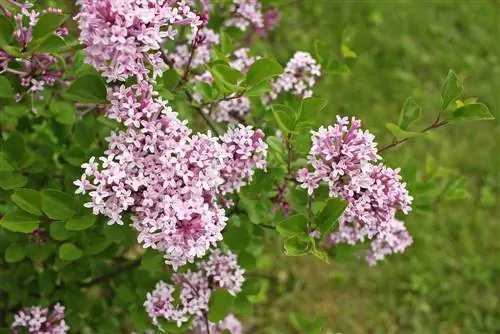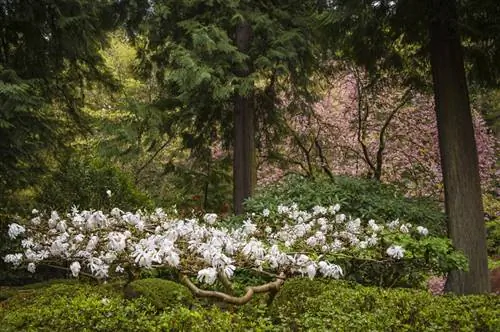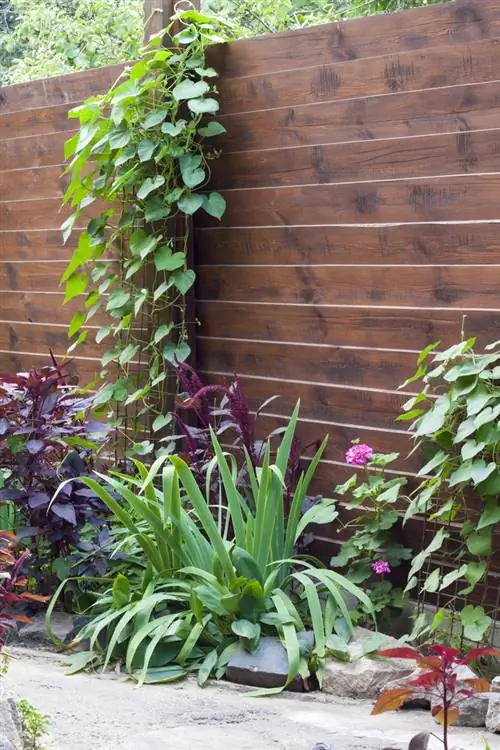- Author admin [email protected].
- Public 2023-12-25 17:45.
- Last modified 2025-01-23 11:21.
A dwarf lilac provides colorful accents in the garden. But its special growth characteristics make the shrub the ideal container plant that also beautifies small front gardens and balconies. The robust garden beauty with the aromatic floral scent has special requirements in terms of care and location.

What is special about dwarf lilacs?
The dwarf lilac (Syringa meyeri) is a slow-growing, compact shrub that is ideal for small gardens, potted plants and balconies. It blooms from May to July with fragrant, colorful flowers, prefers sunny to partially shaded locations and has medium water requirements.
Origin
The dwarf lilac is also known as Meyer's lilac, derived from the scientific name Syringa meyeri. It belongs to the olive tree family and originally comes from northern China. Here the tree grows in Liaoning Province, where it shapes shrub areas on mountain slopes.
Growth
Meyer's lilac grows as a 1.5 meter high shrub. It forms a loose shape. Its branches are slightly square and may be bare or somewhat downy. The shrub grows very slowly but continuously. Due to its compact shape, it requires little space.
Bloom
Dwarf lilac bushes develop small individual flowers in panicle-shaped inflorescences. The flowers are between 2.5 and ten centimeters long. They consist of a dark purple calyx and a corolla, the petals of which have grown into a corolla tube in the lower part. The tips are spread out and can be blue-violet, bluish with pink or red nuances or completely white.
The flowering period extends from May to July. In wind-protected locations, the shrub blooms a second time in late autumn. Young plants are already blooming profusely. The flowers exude a sweet scent.
Fruit
Meyer's lilac develops capsule fruits that scatter their seeds. The fruits are between one and two centimeters long and are covered with clearly visible pores.
leaves
The leaves are divided into blades and stalks. The leaves are between one and five centimeters long and wide, elliptical or egg-shaped. The blade is short, pointed or blunt. Their base is wedge-shaped or rounded.
The prominent leaf veins, which extend palm-shaped over the green-colored leaf blade, are striking. The underside of the leaf appears lighter and is hairy along the leaf veins.
Usage
Syringa meyeri is ideal for beautifying small gardens. It can be planted as a hedge or as a solitary plant. The Asian beauty cuts a particularly good figure as a border for beds. The dwarf lilac is suitable for planting in containers. This way you can give your balcony a spring-like atmosphere. The tree can be cultivated as a bonsai or standard tree.
The inflorescences of the dwarf lilac are suitable as cut flowers for creating bouquets or as table decorations in vases. Cut off the longest shoots possible and then remove all leaves.
How to extend the blooming time of cut flowers:
- Cut the branch base lengthwise
- Dip the stems briefly into warm water
- fill a tall vase one third full of water
- Change water every two to three days
High trunk
Varieties that grow at least 1.50 meters high can be grown as standard stems. In this form, the shrub develops a trunk that ends in a richly branched crown. Such tree-like specimens require less space and can also be grown in a container. In this way, the dwarf lilac forms an aesthetic eye-catcher in the front garden or as the center of a perennial planting. It can also be placed directly in an open lawn. Several trees create an avenue that lines the main paths and driveways.
Bonsai
Syringa meyeri is ideal for bonsai cultivation. The shrub is grown outdoors all year round. If there is sufficient light, the plant develops enough sugar and oxygen so that it can grow well. The trunk becomes thicker and the leaves become firmer due to wind and rain. This makes the plants more robust against pests and diseases.
Wiring
Dwarf lilacs can be shaped by wiring. Wrap trunks, branches and twigs in a spiral from bottom to top with aluminum wire. Make sure the wire is tight but not too tight. The turns should be evenly distributed. You can then shape the branches into the desired shape. The wire is removed in mid-May, as this is when the growth in thickness begins.
Cut dwarf lilacs correctly
In order to maintain the shape of the bonsai, the shrub must be cut back regularly after flowering. When transplanting, you should shorten the roots so that there is a balance between the root ball and the crown.
Is dwarf lilac poisonous?
Like all Syringa species, dwarf lilac also contains the glycoside syringin. Although it has been classified as non-toxic, consumption of large quantities may cause abdominal cramps, headaches and nausea in sensitive individuals and children. Small amounts are usually harmless. The leaves and flowers of some Syringa species are used to make teas.
Syringin has a similar effect on dogs and cats as it does on the human organism. Due to their size, even small amounts can be enough to cause gastrointestinal problems. As a precaution, you should not plant dwarf lilacs if there are pets in your garden.
Which location is suitable?
The original distribution areas are in dry to fresh locations in sunny to partially shaded locations. When there is less sunlight, the shrub blooms less profusely. The dwarf lilac cannot tolerate permanently moist conditions. To prevent such conditions from occurring, you should loosen up impermeable soils with sand. The shrub is considered robust because it can tolerate both heat and cold. The city climate doesn't cause him any problems
What soil does the plant need?
The dwarf lilac grows on slightly acidic to strongly alkaline soils. The pH value is ideally between 6.0 and 7.5. It thrives on both sandy and loamy soils if they contain a certain amount of humus. Nutrient-rich soil is important for dwarf lilacs to grow lushly.
Sowing
Shrubs propagated by seeds develop flower and leaf colors that combine the characteristics of two parent plants. This way you can breed new varieties that develop into individual, magnificent specimens.
After flowering, harvest the fruit heads. You can use a sieve to separate wilted leaves and plant parts from the seeds. Fill a planter with potting soil and scatter the seeds evenly. Place the pot in a cool and shady place. The winter cold encourages the seeds to germinate next spring.
In spring, make sure the soil never dries out. To increase humidity, you can cover the pots after winter or place them in a greenhouse. The seeds still require cool temperatures. When the young plants have grown a few centimeters high, they can be pricked out. Planting outdoors is possible from autumn onwards.
Cuttings
With this method you can create an identical image of the mother plant. When flowering, cut off shoots that have at least three leaf nodes. You should choose young shoots that are not yet woody.
The cut is made just below or above a leaf node. The roots can later form in these places. Remove the lowest leaves from the shoot. Cut the bark crosswise at the bottom so that the cutting can absorb water. Insert the shoot into potting soil that you have previously mixed from soil, sand and algae lime.
It takes a few weeks for the cuttings to develop roots. Many young plants only begin to develop fresh shoots the following spring.
Dwarf lilac in a pot
When cultivating in containers, you should use garden soil that meets the substrate requirements. Mix in some sand or perlite so that the soil does not compact so quickly and becomes more permeable. This also prevents mold formation.
The right planter:
- 20 to 30 centimeter high bushes require a volume of 3.5 liters
- 60 to 80 centimeter high bushes prefer a 15 liter pot
- Tall stems with 100 centimeters grow in pots with a volume of ten liters
Balcony
The dwarf lilac is perfect for beautifying balconies. Its growth is limited. Regular pruning of shoots and roots keeps the shrub compact and small. It can stay outdoors all year round as it doesn't mind frosty temperatures. In particularly harsh winter months, you should protect the planter accordingly.
Watering dwarf lilacs
Syringa meyeri has a medium water requirement. It likes a fresh substrate and is sensitive to waterlogging. Short-term dry periods do not cause any problems for the roots as long as they do not last too long. When the leaves become limp, the next watering is due. If you are cultivating it in a container, you will need to water the shrub more regularly.
Fertilize dwarf lilacs properly
Dwarf lilacs enjoy fertilization before and after the flowering period. Provide the plant with compost in spring and fall. The early supply of nutrients ensures particularly lush flowers and promotes growth.
Work horn shavings into the soil and give the plant a slow-release fertilizer so that it can draw on the nutrients all year round. Avoid fertilizers that contain a lot of nitrogen. This results in reduced flowering and your shrub has less scent.
Cut dwarf lilacs correctly
Pruning is usually not necessary. To support the dense growth habit, you can thin out the bush a little after flowering. If there is a lack of space, you can cut the bush back radically. This measure is well tolerated because the bush sprouts again from the old wood. However, there will be no flowering next spring because the dwarf lilac develops its flower buds the previous year.read more
How do I transplant correctly?
The older the dwarf lilac is, the more difficult it is to transplant. The roots can be quite extensive. This measure should be done in the spring before flowering so that the shrub can settle in the new location by winter. Before digging, cut the shrub back so that it has a compact shape. Ideally, there should be a balanced relationship between shoots and root balls. Rooting is easier the less leaf mass the remaining roots have to supply with nutrients.
Dig off a large root ball and dig out the substrate. Place the shrub in the prepared planting hole and fill any gaps with the excavated soil. The shrub is then watered thoroughly so that the soil can close. A pouring rim prevents the water from running off the surface.
Repotting
The slow-growing dwarf lilac only needs to be planted in a new container after a few years. The potted plants enjoy a change of substrate every three years. If you want to keep the shrub small, you can shorten the roots.
Wintering
The dwarf lilac is hardy and can survive the frosty temperatures in a location protected from the wind, even without winter protection. Icy drafts cause problems for the plant. You should protect the shrub in such exposed places. Cover the ground with straw, sticks or pine branches to protect the roots.
Potted plants are more sensitive to frost because the soil in the pot freezes quickly. Place the planter on a Styrofoam plate or a piece of wood in a place protected from the wind so that the cold from the ground does not penetrate the pot. In particularly harsh winter months, you can wrap the bucket with foil or jute.
Pests
Weakened shrubs are occasionally attacked by aphids or mealybugs. These pests feed on the plant sap, which further weakens the dwarf lilac. Wipe affected plant parts with a cloth that you have previously soaked in a detergent solution. As a preventive measure, you should ensure an optimal supply of nutrients so that the plant's immune system is not weakened.
Fungal infestation
Waterlogging causes the roots to rot. This causes fungal spores of the genus Phytophthora to settle, which damage the plant. By acting quickly you can save your plant. Dig up the bush and generously cut off any rotten roots. Shorten the remaining roots and let the ball air dry for 24 hours.
Plant the shrub in fresh substrate and shorten the branches so that the plant can regenerate more quickly. Avoid watering. The first watering is done after three or four days. It takes about two weeks for the dwarf lilac to recover.
Dwarf lilac not blooming
If the dwarf lilac does not bloom, a late change of location may be the cause. If the shrub is moved after the flowering period, buds often do not form in the fall. You should always move the tree before it flowers.
Tip
Woods that develop their splendor after the dwarf lilac has bloomed prove to be suitable planting partners. You can create aesthetic plant arrangements with hydrangeas, bearded flowers, garden hibiscus or ranunculus bushes. Early-flowering trees such as weigela or fragrant jasmine are suitable for creating a colorful hedge.
Varieties
- Palibin: Crimson buds open from the end of May, delicate pink flowers. Up to 100 centimeters high. Growth height 80 to 125 centimeters.
- Red Pixie: Flowering period from late spring to mid-autumn, flowers pink to magenta. Spicy floral scent.
- Josee: Extremely hardy variety. Inflorescences slender with pink flowers. Growth height up to 150 centimeters.






